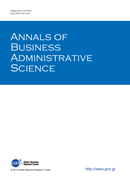All issues

Volume 14, Issue 1
Displaying 1-4 of 4 articles from this issue
- |<
- <
- 1
- >
- >|
-
Rigid Persons Clung onto ItNobuo TAKAHASHI2015 Volume 14 Issue 1 Pages 1-14
Published: February 15, 2015
Released on J-STAGE: February 15, 2015
JOURNAL OPEN ACCESS“Iron cage” appears to be mistranslated from Weber's “Gehäuse” by Parsons. Correctly speaking, it has been noted that the word should be translated as “shell,” which presents an extremely promising possibility in management studies: what appears to be a talisman on the front has rigid persons clinging onto the other side. If a shell has a competitive advantage, this would excuse the rigidity. However, if the shell is losing, or has already lost, its competitive advantage, clinging onto it becomes a problem. For example, Ford and IBM grew rapidly by clinging onto their shells―the Model T Ford in the case of Ford and the System/360 for IBM. However, these companies gradually went into decline later as their product design fossilized. Apart from product designs, it is easy to find examples of shells in companies that have experienced periods of growth and maturity, for example, retail networks, parent company sales power, real estate, patents, and franchise. Both managers and employees are fully aware that they can no longer expect growth as long as they cling onto their shell. Even so, the shell remains a source of rent. Hence, they are clinging onto it and are being driven to their ruin by inches.View full abstractDownload PDF (244K) -
Mysteries in the Original Simulation ModelNobuyuki INAMIZU2015 Volume 14 Issue 1 Pages 15-34
Published: February 15, 2015
Released on J-STAGE: February 15, 2015
JOURNAL OPEN ACCESS
J-STAGE DataThe garbage can model created by Cohen, March, and Olsen (1972) explains organizational decision making under ambiguity. In the initial study outlining the model, a computer simulation was used for analysis. However, despite the appendix of Cohen et al. (1972) providing the Fortran source code for the simulation, subsequent studies rarely made any reference to the simulation model. In this study, we examine the simulation model of Cohen et al. by rebuilding the aforementioned source code. The results of our study clearly indicate the following three points. 1) the program created by Cohen et al. failed to detect the three decision-making styles (decision by resolution, decision by oversight, and decision by flight); 2) decision making sometimes occurred not only when choice opportunities had no problems but also when a choice opportunity had no decision maker; and 3) even when there were no problems attached to choice opportunities, the initial setting was programmed as though there were, perhaps to avoid the decision making seen in 2).View full abstractDownload PDF (364K) -
Yuki MITOMI, Nobuo TAKAHASHI2015 Volume 14 Issue 1 Pages 35-51
Published: February 15, 2015
Released on J-STAGE: February 15, 2015
JOURNAL OPEN ACCESS
J-STAGE DataThe mutual learning model described in “Exploration and Exploitation in Organizational Learning” (March, 1991) concludes that “slow learning on the part of individuals maintains diversity longer, thereby providing the exploration,” based on the results of computer simulations. However, the simulations of March (1991) excluded both ends of the socialization rate domain. When compensating for those missing portions, there is an optimal socialization rate that actually maximizes the average knowledge level. This is because low learning on the part of individuals actually causes frequent lock-ins and impedes learning. This optimal socialization rate may be a common rate for socialization, and we cannot deny this possibility by using only computer simulations. Moreover, this high knowledge level is achieved in a non-equilibrium state.View full abstractDownload PDF (335K) -
Takeaki WADA2015 Volume 14 Issue 1 Pages 53-66
Published: February 15, 2015
Released on J-STAGE: February 15, 2015
JOURNAL OPEN ACCESSWaste is generated as an unwanted byproduct of current business activities. Transforming waste products into a resource can enable firms to obtain raw material for free and reduce the cost of waste disposal. However, in general, firms are hesitant to accept the challenge of utilizing waste products because of organizational learning. Moreover, in the past, all challenges to transform waste products into a resource have failed. Thus, firms must unlearn the organizational learning that waste is “not a resource,” which inhibits their attempt to utilize waste products. Furthermore, in the beginning of development, there is no definite idea, and the process is far from the deliberate strategic process with clear objectives. The development process would be a deliberately emergent strategic process with only rough guidelines for attempting to transform waste into resources by any means. To achieve the objectives, firms have to patiently repeat trial and error, even if there are no short-term outcomes. This paper introduces the development process for N-acetylglucosamine (NAG) at the Yaizu Suisankagaku Industry (YSK) as an example of the successful commercialization of technology that utilizes waste. In the YSK example, (1) the spirit of mottainai that increases the value of the material to the maximum and becomes a significant driving force for unlearning, and (2) the leaning on the future principle in which one continues without losing hope even if there are no short-term results were the critical aspects that led to the successful transformation of waste into resources and is referred to as mottainai innovation.View full abstractDownload PDF (264K)
- |<
- <
- 1
- >
- >|